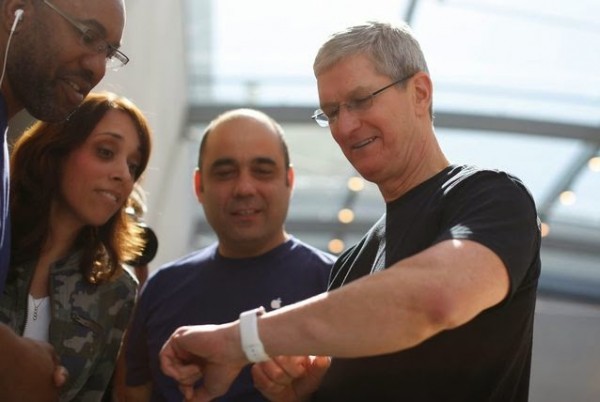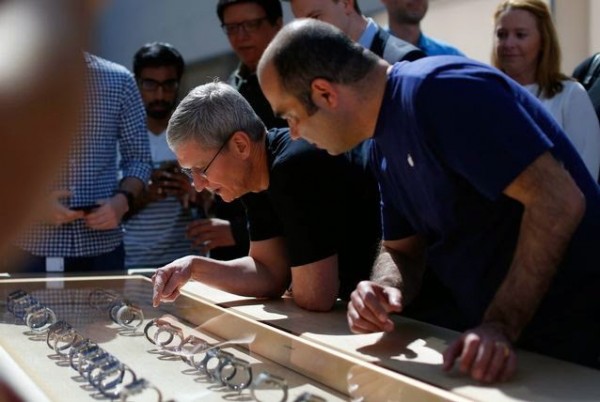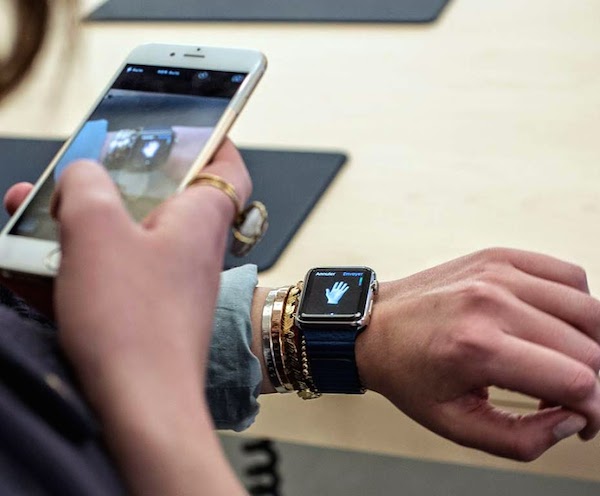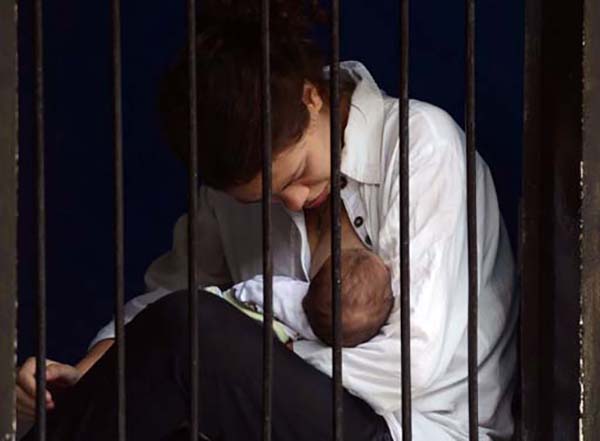Notes
Watch This Digital Life
Time goes by quickly. Just look at how fast technology changes, and look at how fast technology changes us. Remember iPad? Already, we’re swiping apps right before bedtime and it feels normal. But iPad is so two thousand and ten, isn’t it? Ancient history in computer time. Today it’s Apple Watch, seen in this photograph being proudly displayed by Apple CEO Tim Cook. Hey check this out you guys: our advancement from desktop to wristwatch comes in at just under forty years. So, yes. Now you really can watch time fly.
What you can do with the watch is also a story about what it can do with you. Just strap it to your wrist and it will commence with reading your vital signs. That indeed takes the ‘personal’ in personal computing to a new level of intimacy, but according to Cook’s sales pitch, that kind of intimacy was in the plan all along. All of a sudden there goes another menacing intrusion, some say, of digital devices and droid technology into the once pristine, organic domain of the human body. What’s next? Brain implants? In our hasty march toward cyborg anthropology, we catch ourselves wondering who, or what, is really driving the action. When we bristle at the way digital technology infiltrates our somatic experience, we fall back into a humanist tendency to imagine human beings–not inanimate objects–as the only star of the show. And yet, that reminder to Look Up suggests that when it comes to organizing daily patterns of mobility and interaction, our machines steer us around just as much as we do.
Humanity’s relationship to digital technology isn’t exactly a new concern. Researchers have been grappling with digital implications for some time now. Just this past weekend, while (almost) all eyes were on Apple Watch, researchers gathered at the Indiana University Digital Rhetoric Symposium in a collaborative effort to come to terms with social immersion in digital worlds. Against an inclination to think of digital domains as “virtual,” a number of scholars at #IDRS15 emphasized how deeply the virtual is bound up in the physical. Though easy to forget, ultimately it is the human body-moving-around in what Byron Hawk calls a “gestural ecology”––an expansive range of physical practices like pressing buttons, pulling plugs, unpacking equipment, setting it up, positioning earbuds, untangling wires, soldering circuit boards, turning knobs, turning screws, each activity composed from bodily gestures that are part of an infinite range of improvisational actions that not only make digital technology happen, but also happen because of digital technology.
The above photograph of Tim Cook huddling with onlookers shows people looking at a watch, sure, but it also shows four individuals comporting themselves in gestural responses to the draw of a supposedly ‘inanimate’ digital device. If we’re skeptical that human gestures can entail as much of a reply to technology as a control of technology, this photograph illustrates the point:
Very much in sync with the #IDRS15 idea that digital can replicate rhetorical, this photograph of Cook and company peering through a looking glass shows just how much using and being used can mirror each other.
Conversations at #IDRS15 didn’t just interrogate the relationship between digital and social, of course. Given the Bag’s commitment to providing a hub for cross-germination between photojournalists and academic researchers, we should emphasize a strong mutual interest with fellow travelers at #IDRS15 on questions about the meaning and significance of engaging social experience through visually––which increasingly entails digitally––mediated formats. How do we make sense, for example, of that we’re seeing, or what is being seen, in this next photograph?
Call it Selfie 2.0. In this photograph directing a smartphone camera to a new wristwatch illustrates how the self gets mediated through the digital even as (the appearance of) purchasing digital technology can now stand in for the self. A new device on your arm now works just fine as an identity marker.
But is it digital narcissism? For digital rhetoricians like Elizabeth Losh, the selfie is less about self-admiration than it is about networking practices that involve looking ahead to sharing a social experience with others through visual media. Photojournalists have a role to play, too, when they produce images that layer screens within screens, and when they circulate images, like this one, that let the rest of us in on the practice of sharing. Just last week, reflecting on this growing trend where photojournalists take photographs of people taking pictures, John Lucaites makes a similar observation and suggests that all these new digital cameras give people a way to actively participate in, rather than simply observe, the events and occurences that shape public life. The selfie isn’t about a lone me; it’s about a chorus of us. Photographs like this one help us imagine what holding hands can look like in a digital world.
In an overly-crowded public media space where it can seem like there isn’t much elbow room for academic voices, event convergences like Apple Watch and #IDRS15 demonstrate the immediacy and relevance of academic thought to a fast-moving internet discussion. And it’s getting easier to see how the digital domain helps facilitate more and more institutional boundary crossing. This is just another way of saying that participation in the digital realm actually means that an unlikely amalgam of individuals and groups are sharing a wide array of physical experiences. And so, if digital is the new physical, then these photographs of the Apple Watch aren’t just showing us a technological breakthrough. What’s noteworthy is the way they show how worlds that seem disjointed––human/digital, not to mention academic/public––are in fact underwritten by a strong mutual relationship.
— Philip Perdue
(photo 1&2: Stephen Lam/stringer/Getty Images. caption 1&2: Apple CEO Tim Cook displays his personal Apple Watch to customers at an Apple Store on April 10, 2015 in Palo Alto, California. The pre-orders of the highly-anticipated wearable from the tech giant begins today as the watches arrive at stores for customers to preview. photo 3: Philippe Merle/stringer/Getty Images. caption 3: A customer uses an iPhone 6 smartphone to take a photo of a model of the Apple Watch during the device presentation at the Apple Store in Lyon, central-eastern France, on April 10, 2015. Tech fans got their first look on April 10 at the Apple Watch, with would-be early buyers queuing for a ‘trial fitting’.)





Reactions
Comments Powered by Disqus